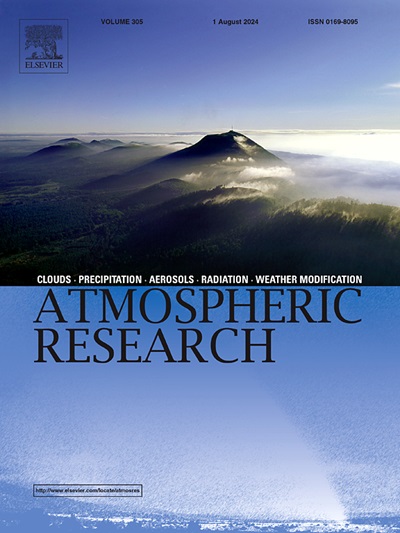Evaluation of the hydrological utility of the GPM IMERG satellite precipitation products
IF 4.5
2区 地球科学
Q1 METEOROLOGY & ATMOSPHERIC SCIENCES
引用次数: 0
Abstract
Satellite precipitation products (SPPs) provide valuable information for hydrological modelling. This paper presents an evaluation of the hydrological utility of in total six Integrated Multi-satellitE Retrievals for GPM (IMERG) products. Specifically, as to the IMERG V06 and V07, both the near-real-time products, i.e., Early and Late, and the post-real-time product, i.e., Final, are evaluated at the daily timescale. Based on the GR4J hydrological model, three numerical experiments respectively focusing on the accuracy of precipitation estimation, the usefulness in streamflow simulation and the effectiveness in flood simulation are devised. Through a case study of 20 catchments across 5 climate zones in Australia from 2000 to 2021, the results highlight that the IMERG V07 products generally outperform the IMERG V06 products in the hydrological utility. For the accuracy of precipitation estimation, the relative bias (rBias) at the point scale of the IMERG V07 products tends to be lower than that of the IMERG V06 products. The median rBias is respectively −31.17% and −16.61% for the IMERG V06 and V07 Early products, is respectively −29.11% and −12.77% for the IMERG V06 and V07 Late products and is respectively −7.83% and −7.46% for the IMERG V06 and V07 Final products. There are evident improvements in streamflow simulation from the IMERG V06 products to the IMERG V07 products, with the median Kling-Gupta efficiency (KGE) increasing from 0.32 to 0.40 under the Early products, from 0.33 to 0.41 under the Late products and from 0.59 to 0.61 under the Final products. Regarding flood simulation, the percent bias in the flow duration curve high-segment volume (FHV) is reduced from the IMERG V06 products to the IMERG V07 products, with the median FHV increasing from −61.52% to −39.29% for the Early products, from −59.28% to −35.18% for the Late products and from −38.85% to −30.64% for the Final products. Taken together, the evaluation of hydrological utility facilitates valuable insights into the applications of the IMERG products to precipitation monitoring, hydrological modelling and flood forecasting.
评估GPM IMERG卫星降水产品的水文效用
卫星降水产品(SPPs)为水文模拟提供了宝贵的信息。本文对六种综合多卫星反演GPM (IMERG)产品的水文效用进行了评价。具体而言,对于IMERG V06和V07,在每日时间尺度上对近实时产品即Early和Late以及后实时产品即Final进行了评估。基于GR4J水文模型,设计了降水估算精度、流量模拟有效性和洪水模拟有效性三个数值实验。通过对2000年至2021年澳大利亚5个气候带20个集水区的案例研究,结果表明IMERG V07产品在水文效用方面总体优于IMERG V06产品。在降水估计精度方面,IMERG V07产品在点尺度上的相对偏差(rBias)倾向于低于IMERG V06产品。IMERG V06和V07早期产品的中位rBias分别为- 31.17%和- 16.61%,IMERG V06和V07后期产品的中位rBias分别为- 29.11%和- 12.77%,IMERG V06和V07最终产品的中位rBias分别为- 7.83%和- 7.46%。从IMERG V06产品到IMERG V07产品,径流模拟有明显的改善,早期产品的中位数KGE从0.32增加到0.40,后期产品从0.33增加到0.41,最终产品从0.59增加到0.61。在洪水模拟中,IMERG V06和IMERG V07产品的流时曲线高分段体积(FHV)偏差百分比减小,早期产品的FHV中位数从- 61.52%增加到- 39.29%,后期产品的FHV中位数从- 59.28%增加到- 35.18%,最终产品的FHV中位数从- 38.85%增加到- 30.64%。总之,对水文效用的评估有助于对IMERG产品在降水监测、水文建模和洪水预报方面的应用提供有价值的见解。
本文章由计算机程序翻译,如有差异,请以英文原文为准。
求助全文
约1分钟内获得全文
求助全文
来源期刊

Atmospheric Research
地学-气象与大气科学
CiteScore
9.40
自引率
10.90%
发文量
460
审稿时长
47 days
期刊介绍:
The journal publishes scientific papers (research papers, review articles, letters and notes) dealing with the part of the atmosphere where meteorological events occur. Attention is given to all processes extending from the earth surface to the tropopause, but special emphasis continues to be devoted to the physics of clouds, mesoscale meteorology and air pollution, i.e. atmospheric aerosols; microphysical processes; cloud dynamics and thermodynamics; numerical simulation, climatology, climate change and weather modification.
 求助内容:
求助内容: 应助结果提醒方式:
应助结果提醒方式:


